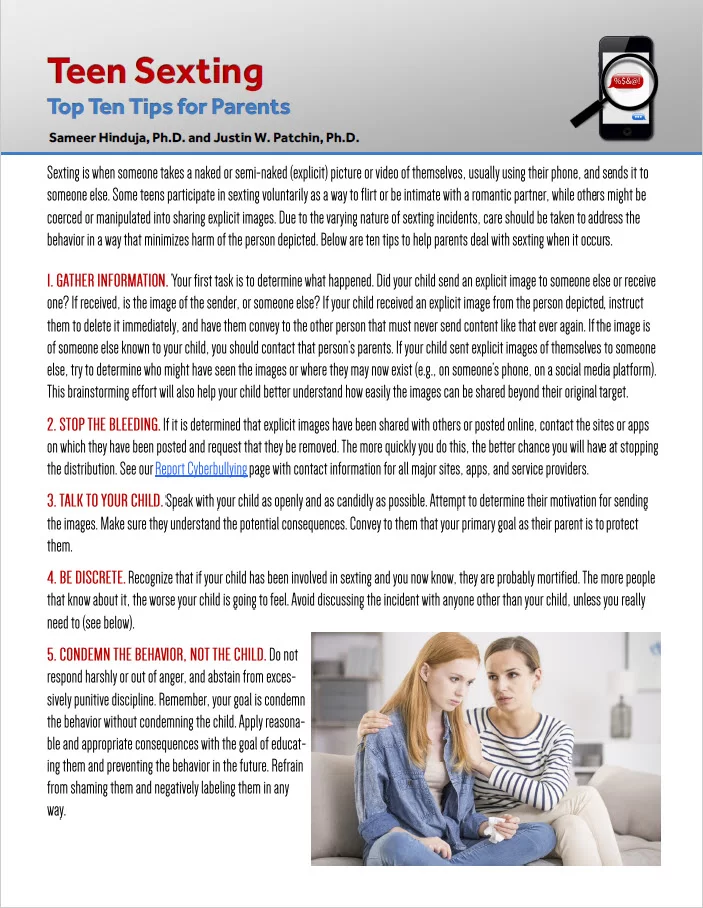
(For a formatted .pdf version of this article for distribution, click here]).
Sexting is when someone takes a naked or semi-naked (explicit) picture or video of themselves, usually using their phone, and sends it to someone else. Some teens participate in sexting voluntarily as a way to flirt or be intimate with a romantic partner, while others might be coerced or manipulated into sharing explicit images. Due to the varying nature of sexting incidents, care should be taken to address the behavior in a way that minimizes harm of the person depicted. Below are ten tips to help parents deal with sexting when it occurs.
1. GATHER INFORMATION. Your first task is to determine what happened. Did your child send an explicit image to someone else or receive one? If received, is the image of the sender, or someone else? If your child received an explicit image from the person depicted, instruct them to delete it immediately, and have them convey to the other person that must never send content like that ever again. If the image is of someone else known to your child, you should contact that person’s parents. If your child sent explicit images of themselves to someone else, try to determine who might have seen the images or where they may now exist (e.g., on someone’s phone, on a social media platform). This brainstorming effort will also help your child better understand how easily the images can be shared beyond their original target.
2. STOP THE BLEEDING. If it is determined that explicit images have been shared with others or posted online, contact the sites or apps on which they have been posted and request that they be removed. The more quickly you do this, the better chance you will have at stopping the distribution. See our Report Cyberbullying page with contact information for all major sites, apps, and service providers.
3. TALK TO YOUR CHILD. Speak with your child as openly and as candidly as possible. Attempt to determine their motivation for sending the images. Make sure they understand the potential consequences. Convey to them that your primary goal as their parent is to protect them.
4. BE DISCRETE. Recognize that if your child has been involved in sexting and you now know, they are probably mortified. The more people that know about it, the worse your child is going to feel. Avoid discussing the incident with anyone other than your child, unless you really need to (see below).
5. CONDEMN THE BEHAVIOR, NOT THE CHILD. Do not respond harshly or out of anger, and abstain from excessively punitive discipline. Remember, your goal is condemn the behavior without condemning the child. Apply reasonable and appropriate consequences with the goal of educating them and preventing the behavior in the future. Refrain from shaming them and negatively labeling them in any way.
6. CONTACT OTHER PARENTS. If there is evidence that other youth possess images of your child, contact the other parents and advise them of what is going on. Work together to informally address the behaviors in a way that stresses to the youth that these behaviors are very risky and could lead to significant reputational and even legal trouble that lasts for a long time. The goal is to stop the distribution of the images. If other parents don’t seem to be taking it seriously, you may need to enlist help from a school official or even law enforcement in extreme cases.
7. CONTACT THE SCHOOL. If explicit images have been distributed to students beyond the original sender and receiver, the school should be contacted so that they can conduct an investigation. School discipline may be appropriate if there is a substantial school disruption because of the situation, or if a student is being bullied or otherwise targeted as a result of the image(s).
8. CONTACT THE POLICE. If you have a concern that your child is being targeted and exploited by another child or even an adult, contact law enforcement as soon as possible so that they can immediately get involved. Adults (and sometimes minors) can be charged criminally for possessing and distributing sexually explicit images of minors, In many states it is a crime to request explicit images from minors (termed “child enticement”).
9. SEEK PROFESSIONAL HELP. The distribution of explicit or private images beyond their original target can be emotionally and psychologically damaging for anyone (and especially for youth). Consider obtaining formal counseling services from someone who works extensively with adolescents to help your child process what happened and move forward. They likely feel devastated, helpless, and that their lives will never be the same again. A specially-trained therapist or similar mental health professional can be of great benefit.
10. OFFER ALTERNATIVES TO SEXTING. It is completely normal for teens to want to be intimate with their romantic partners. Give your child age-appropriate suggestions for flirtation/intimacy that do not carry the same risks as sending or receiving explicit images. For example, they could send a suggestive image, rather than an explicit one. They could send an audio message instead of a video. They could send a link to something playful and flirty. All of this may shock your sensibilities, but such creative solutions can at least partially have the desired effect.
Citation information: Hinduja, S. & Patchin, J.W. (2021). Sexting: Advice for parents. Cyberbullying Research Center. Retrieved [insert date], from https://cyberbullying.org/sexting-advice-for-parents.pdf
Keywords: sexting, teens, parents, parenting, tips, prevention, explicit images, nudes







